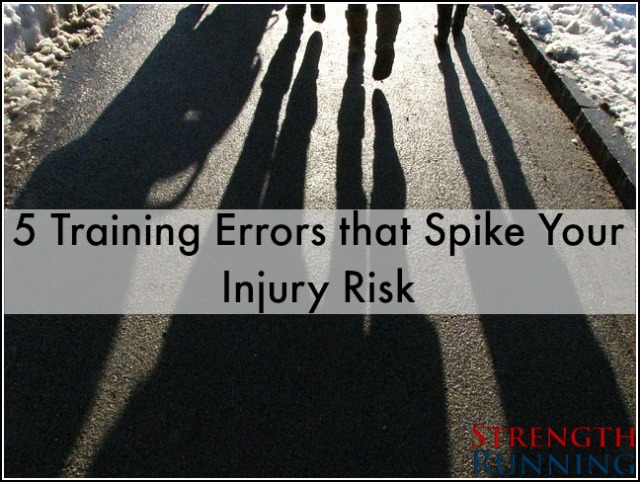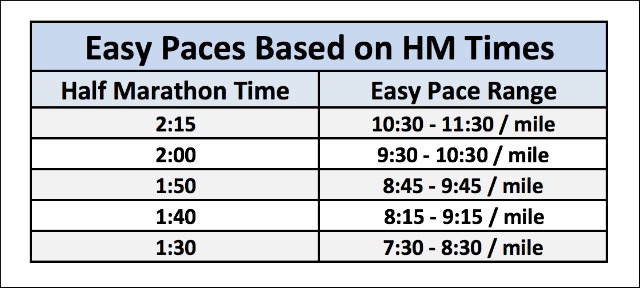POP QUIZ: Do you know why most runners get injured? I bet you don’t…

To answer this question, many runners will go through a laundry list of issues that might cause an injury:
- I wore the wrong pair of shoes
- I went out too fast in my last Park Run
- I stayed out too late, didn’t stay hydrated, visualized the wrong thing…
No.
None of these are why you might get hurt.
For the vast majority of runners, these are not the factors that cause injury. Not even close.
The real reason is what my college coach Jim Butler called “The Three Too’s” – running too much mileage, too soon before you’re ready, at too fast a pace.
In other words, injuries are caused by training errors.
Do the wrong thing (over a prolonged period of time) and you can rest assured that you’re probably going to get hurt.
Recently I interviewed Staci Ardison in our monthly interview series for Team Strength Running about weight lifting and asked about injuries in the weight room. What causes them? How do you stay healthy while lifting?
Her answer was surprising. It wasn’t a neat new trick or fancy wrist strap for dead lifts.
It had nothing to do with what shoes you’re wearing or whether or not you were wearing compression socks.
Her answer was this:
Not doing things correctly. Don’t ego lift.
How simple. And also, how accurate.
In the sport of weightlifting (just like in running), injuries are caused by doing things you’re not prepared to do.
I want to provide a bit more nuance on these training errors so let’s dive into the top 10 mistakes we make as runners.
#1 Weekly Mileage is Skyrocketing
Most runners understand intellectually that you shouldn’t increase your mileage too quickly.
Doing so introduces a lot of stress and your body simply can’t keep up. While you’re perfectly capable of building endurance, speed, and strength, it doesn’t happen in a week or two. This process takes years and years.
But in reality, we’ve all done this…
The race we have on the schedule is fast approaching and (oops!) we’re not quite prepared yet. So we jack up our long run and hope for the best.
This almost always leads to a vicious cycle of never-ending injuries, missed races, and lasting disappointment.
After all, rushed training is risky training.
Before you register for your next race, figure out how much you’re going to run over the course of the season and plan accordingly.
Here are a few resources to help:
- The Season Planner Worksheet
- How to Increase Running Mileage (for Competitor)
#2 You’re Running Too Fast
I see this almost every day. I bet you are running most of your mileage at a pace that’s simply too aggressive.
A helpful tool like a running calculator will tell you what your easy paces should be based on your race performances.
In other words, you have to earn fast training paces by racing fast.
Without faster races, you have to slow down.
Here are a few examples based on half marathon time:

You might be asking why the range is fairly wide – that’s because sometimes you feel tired or sore. It’s ok to run on the slow end of this range! Faster is not necessarily better.
The slower end of this pace range is also best thought of as your “recovery” pace while the faster end of this range is your standard “easy” pace.
When in doubt, run slower. You won’t lose any fitness – but you’ll dramatically reduce your injury risk.
Some other context on this issue:
- “When do I increase the pace of my faster workouts?” (video)
- How to pace every run, workout, and race
#3 No Training Variety
Overuse injuries are technically repetitive stress injuries. They’re the result of a relatively small stressor, applied relentlessly over and over again.
Here’s a good example: you might pronate a little more than you should. This doesn’t become a problem until you start running for more than 4-5 hours per week.
At that point, your feet get sore, your arch and plantar fascia become tight (especially in the morning), and your risk of plantar fasciitis increases dramatically.
How do we conquer this obstacle? How do we allow this runner to train more?
There’s not much we can do to limit the repetition of running – our sport consists of one simple movement, after all.
But there are small ways to mitigate this stress and limit it from causing injuries. We can:
- Rotate 2-3 pairs of running shoes so our feet and lower legs experience varying stress while running
- Perform strength workouts and mobility routines that force us to move differently
- Run a variety of paces throughout the week rather than the same pace over and over again
- Run trails to change the mechanics of how our feet impact the ground
With a properly structured program, you’ll vary the distance, pace, and overall effort throughout your training. Smaller changes (like shoes and trails) can be implemented on top of that plan.
If you’re not sure how to structure your own program, consider a custom running plan.
#4 But I Want it NOOWWW
Impatience can be a virtue: it can drive you to succeed and push you to be better. Impatience can light a fire under your ass.
But it can also push you to run too much, too soon, too fast.
Since running is a long-term sport that requires a long-term outlook, you have to be patient.
Adopt the mindset of one of the best college coaches ever: University of Colorado at Boulder XC coach Mark Wetmore. Asked about his “secret weapon,” he replied:
We don’t have any secret weapons…the cornerstone [of our program] is the long-term, patient development of the aerobic metabolism.
With a patient approach to training, you won’t rush your training to get ready for an upcoming race.
There are so many scenarios where this principle will save you from injuries:
- “I’d like to race a marathon in 10 weeks but my current long run is about 6 miles.”
- “My running club was doing 10x400m so I thought I could too…”
- “My half marathon PR is 2:15 but I’d like to train for a sub-4 marathon.”
- “I’ve been struggling with running consistency, but I promised my friends I’d do Ragnar.”
And the list could go on…
Instead of making these poor training decisions, you’ll have the perspective needed to slow down and actually do less.
When in doubt, sit it out.
You’ll be a healthier – and ultimately, faster – runner when you exercise the discipline to live to run another day.
A helpful way to accomplish this is by hiring a running coach. A good coach will be able to provide that perspective and guide you in the most productive direction.
#5 Weak Runners = Injured Runners
A foundation of strength makes running a lot easier.
Just consider the benefits:
- You’re more resilient to training errors (so even if you do make a mistake, you might not get hurt)
- The impact forces that travel up your legs from running downhills or hard surfaces like concrete are mitigated
- Your capacity for a higher workload is increased, making mileage and intensity increases far more manageable
Strength training is so important that I don’t consider it cross-training. It’s simply part of your training as a runner.
Not sure where to start? A progressive approach to adding strength work is the best idea.
If I were to design the ideal strength program for distance runners, it would include several pieces:
- Runner-specific core routines (a singular focus on “abs” is not enough!)
- Bodyweight strength routines that focus on the hips and glutes
- Two lifting workouts per week in the gym, focusing on strength and power
This approach aids recovery, improves strength, develops power, increases speed, and prevents injuries.
There’s not much better than that for distance runners!
Want to learn more? Listen to strength and conditioning coach Tony Gentilcore on why runners need to lift.
How do Elites Stay Healthy?
Avoid these mistakes and you’re well on your way to running stronger and healthier than ever before.
I know that if you can string together a full 1-2 years of consistent training, you’ll absolutely smash your current personal bests.
Now, I understand that I don’t have all the answers.
It’s best to hear from a variety of experts in the running industry on how best to prevent injuries.
That’s why I invited orthopedist Dr. David Geier on prevention for kids. Or spoke with coach James Dunne about keeping bigger runners healthy.
And it’s why learning from elite runners can be so valuable.
These are runners who are putting in 100+ miles per week, running grueling workouts, and suffering through 100-mile trail races.
The insights from the world’s best can help steer us in the right direction and focus our energy on what actually works.
That’s why I interviewed 9 elite athletes on their favorite injury prevention strategies – and put it all together for you here.
Hear from Dathan Ritzenhein, Ian Sharman, Amelia Boone, David Roche, Kelly O’Mara, Joseph Gray, Andy Wacker, Devon Yanko, and Max King on their preferred methods for staying healthy.
But also note what they don’t recommend.
Avoiding the wrong things is often just as important as doing the right things.
Download your free copy now – and here’s to healthy, happy running!
